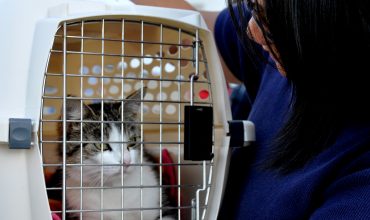[print-me] House Soiling Or Urine-Marking? How To Tell The Difference! Your pet may be urine-marking if: The problem is primarily urination. Dogs and cats rarely mark with feces. The amount of urine is small and is found primarily on vertical surfaces. Dogs and cats do sometimes mark on horizontal surfaces. Leg-lifting and spraying are common versions of urine-marking, but even if your pet doesn’t assume these postures, he may still be urine-marking. Any pet in your home is not spayed or neutered. Both intact males and females are more likely to urine-mark than are spayed or neutered animals. However, even spayed or neutered animals may mark in response to other intact animals in the
Read More
Archives for Behavior tips
Positive Reinforcement: Training with treats and praise
[print-me] Positive reinforcement is the presentation of something pleasant or rewarding immediately following a behavior. It makes that behavior more likely to occur in the future, and is one of the most powerful tools for shaping or changing your pet’s behavior. Correct timing is essential when using positive reinforcement. The reward must occur immediately, or your pet may not associate it with the proper action. For example, if you have your dog sit, but reward him after he’s already stood up again, he’ll think he’s being rewarded for standing up. Consistency is also essential. Everyone in the family should use the same commands.
Read More
Your new cat & the litter box
[print-me] Most cats have a specific preference about where they want to eliminate. By following the suggestions outlined here, you’ll be able to start off on the right foot with your new cat. Location The most important aspects of location are the need for it to be quiet, easily accessible, and not near the feeding and water stations or any comfort items. Most people are inclined to place the litter box in an out-of-the-way spot in order to minimize odor and loose particles of cat litter in the house. Often, the litter box ends up in the basement, sometimes next
Read More
Rough play in a kitten or adult cat
Is your kitten or cat playing too rough? Here's what to do.
Read More
Managing scratching
[print-me] By nature, cats have a need to scratch objects in their environment. We know that cats leave their scent behind when they scratch things and that this is a means of letting the world know that they’re there… whether it is to warn another cat away or to invite them to play. They tend to go back to the same spots and scratch those spots repeatedly for this reason; it’s another way for them to mark their territory. Even cats who have been declawed will try to scratch things for this very reason! Scratching also happens in play, as
Read More
Kitten-proofing your home
[print-me] When bringing a kitten home, there are a few easy steps that you can follow to keep your little bundle of fluff safe in their new environment. It’s best to take a look around before you bring your kitten home. The real secret to kitten-proofing is to look at your home through the eyes of a cat. Find everything that looks like a fun toy, and if it’s something harmful, get rid of it or make it safe. Having her home prepared for her arrival will make the transition much easier for all of you! Look around your house
Read More
Cat Toys For Fun and Enrichment
[print-me] Cats, like people and dogs, benefit from keeping fit and active, both mentally and physically. Exercise is essential for your cat’s mental and physical health because it relieves stress and boredom, improves circulation, builds muscle tone and can prevent or reduce behavioral problems. So, we need to get our cats up and moving, and there’s no better way to coax out their natural instincts to stalk and chase prey than by engaging them with toys. Types of Toys for Fun and Games Wand Toys A wand toy can be as simple as a stick with a thin piece of
Read More
Cat to Cat introductions
[print-me] If you’re bringing a new cat into your home, be patient. The introduction must be gradual. Following the initial introduction, it can take some time for a relationship to grow. It can take months or even years for some cats to develop bonds with other cats. Although some cats certainly become close friends, others never do. Many cats who don’t become buddies learn to live peacefully with one another, while others become fast friends. Sadly, it’s difficult to predict whether or not any two individual cats will get along. There are no reliable guides for deciding the best matches
Read More
Cost of Owning a Cat
[print-me] When you think about the annual cost of care for your cat, there are several things to consider. Cats can live an average of 10-18 years, although some cats may even live into their twenties. Below are general price ranges for the things your cat will need over the course of his/her life. Food Most cats are fine with a typical feline pet food that you can buy at specialty pet stores or even grocery stores. It is important to pay attention to the ingredient list on your cat’s food because often times, you get what you pay for.
Read More
Bringing your new cat home
[print-me] Congratulations on finding your new best friend! Here are some tips to help guide you through the first few days after bringing your new cat home! It’s important to remember that your new cat could be frightened and confused, even if they were happy and outgoing when you met them at the shelter. Cats like routine and to have control over their environment, so it may take them a few days to feel the safety and comfort that they felt in the den they had created for themselves at the shelter. For these reasons, we suggest that you set
Read More












